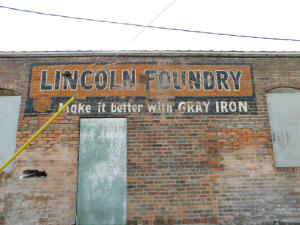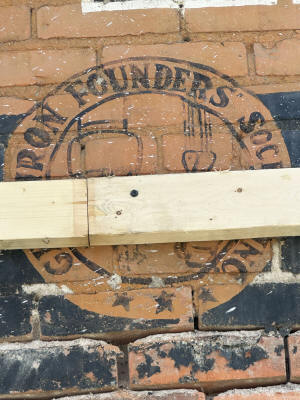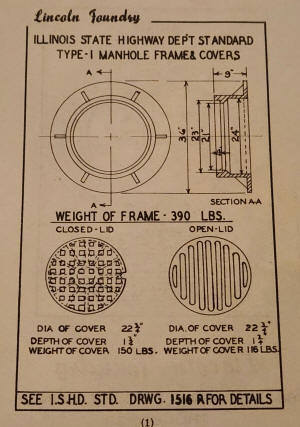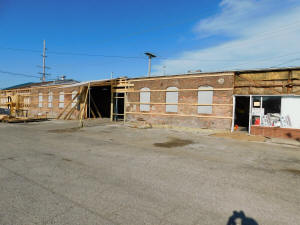|
Modern Brake and Alignment, right
off Limit Street on the east end of Lincoln, is redoing the exterior
of their building. When they recently pulled off the siding they
found signs for the old Lincoln Foundry.
It appears that the building housed the Lincoln Foundry before Ivan
and Elaine Ray bought the building and remodeled it. The Rays built
Modern Brake and Alignment behind that building.


Leigh Henson on his Finding
Lincoln, Illinois website shares information showing that in 1942,
Ralph Weaver bought a building on Limit Street for the Lincoln
Foundry. The brick portion of the building had been “the first floor
of the two-story Lincoln Automobile Factory, built in 1907.”


Additionally, Henson found Howard
Stewart had managed the Lincoln Foundry. This facility “had cast
items like manhole covers, storm drains, and curb drains. The flow
was covered with mold sand—sand mixed with oil and used in the
casting process.”
Because “casting requires wooden
patterns,” Henson said, “Ralph bought his from a woodworking shop in
Pekin and had about 180 different styles and designs. Two overhead
cranes held the big metal ladles used to pour the molten metal
reclaimed from scrap iron that Ralph had purchased.”
[to top of second column] |


The centennial edition of the
Lincoln Evening Courier provided Henson even more details about
the Lincoln Foundry, which in 1953 “produced 150 tons of gray
iron castings used to manufacture agricultural machinery, cast
iron smoke pipe, drainage materials and airport equipment.”
An August 26, 1953, Courier article titled “Lincoln Foundry
Began Operation Over 50 Years Ago” indicates those working in
the foundry had years of specialized training. As the article
said, “[u]nlike many highly mechanized industries where
repetitive mechanical skills prevail, gray iron is essentially a
craft industry. Four years of apprenticeship is normally
required to develop journeyman molders, core makers and pattern
makers, and anywhere from six months to several years to learn
other foundry jobs.”
In June 2010, Henson received an email from Dave Armbrust, who
had seen Henson’s information on the Lincoln Foundry. Armbrust
remembered that he had a catalog of products made at the Foundry
and sent Henson drawings of some of their products.
After seeing a drawing of a manhole cover made by Lincoln
Foundry, Henson was curious whether any of these manhole covers
were on the streets of Lincoln.
To find out, Armbrust spoke to Street Superintendent Tracy
Jackson and City Engineer Mathon who told him there were several
of these manhole covers in various parts of Lincoln. Armbrust
was also told there were catch basins that were part of the curb
drains around Lincoln made by Lincoln Foundry, so he and his
wife began to look for them.
Something Henson said Armbrust found in looking for these drains
is that “some of the curb drains in the first Lincoln namesake
city feature a small (2- by 3-inch) bas-relief of Abraham
Lincoln similar to that on the famous Lincoln penny, originally
created in 1909. These curb drains do not have "Lincoln Foundry"
on them, but it's logical that these "Little Iron Abe" drain
curbs were manufactured by that company.”
It is not completely clear when Lincoln Foundry stopped
production. However, by 1972, the building changed hands when
Ivan Ray bought and remodeled the building.
Though the Lincoln Foundry is long gone, the business’s heritage
lives on through the signs on the building and several manhole
covers and catch basins around Lincoln.
[Angela Reiners | Photos by Nila
Smith & Beverly Buhrmester] |